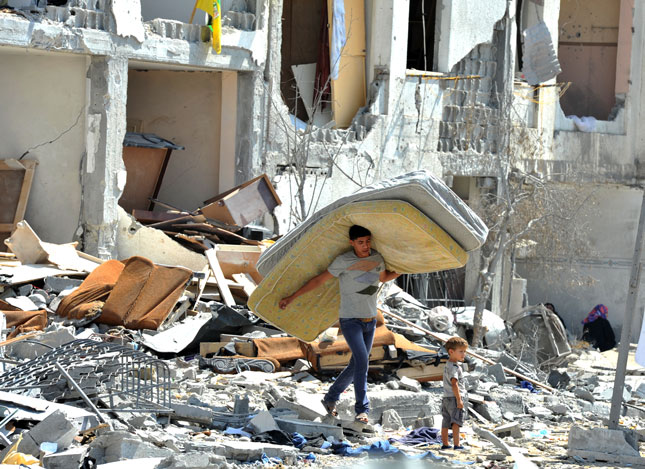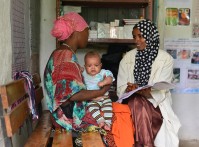-
Accelerating a Cycle of Violence: Tallying the Damage to Gaza’s Youth
August 25, 2014 By Sarah Meyerhoff
Amid stop-and-start ceasefires, the tally of death and destruction from the recent conflict in the Gaza Strip has begun. Whatever the final losses incurred – casualties and damage are considerable with estimates varying significantly depending on the source – Gaza’s youngest residents are likely to be most profoundly affected.
As money for school fees disappear and soldiers grow scarce, young people leave classrooms and enter battlefields
Young people tend to suffer most from violent conflict; as money for school fees disappear and soldiers grow scarce, they leave classrooms and enter battlefields, with consequences that follow them for the rest of their lives. Girls – who are pulled out of school at much higher rates than boys, are more likely to be married off while underage, and are often the targets of sexual violence that accompanies conflict – are particularly vulnerable.
But Gazan youth face an even more severe set of challenges, rooted in the area’s unique demographics, geography, and history of violence. Growing at a rapid rate, Gaza is both one of the most youthful and most densely populated areas in the world, all within a mere 139 square miles that have been blockaded by Israel and Egypt for nearly a decade.
The physical, social, economic, and psychological tolls from the most recent fighting between Hamas and Israel will exacerbate these challenges, shaping the lives of the young people of Gaza for years to come.
Falling Further and Further Behind
There are 1.2 million people under the age of 25 in Gaza, representing 65 percent of the total population. The average age is 18 (compare to the global average of 28). Even with a projected decline in total fertility from 4.4 children per woman to 2.3 by 2030, Gaza’s population is expected to balloon to 2.6 million people by 2030 and 3.4 million by 2050, according to the U.S. Census Bureau.
A 2012 UN report predicted that without major changes, Gaza will be virtually “unlivable” by 2020
How many of the 1,800 to 2,200 Palestinians reportedly killed during the recent fighting were under the age of 25 is up for debate, but high casualty rates can be assumed as most of the territory’s population, as well as the majority of Hamas combatants, are relatively young. There are reports of anywhere between 400 and 500 children killed, and at least 1,000 of the 3,000 injured are expected to suffer lifelong disabilities, according to the UN. Israel has suffered youth casualties as well: 64 soldiers were killed, many of whom were likely under 25 and it was the deaths of three teenage boys that sparked the fighting over a month ago.
Young people also bear the brunt of damage to infrastructure, services, and the economy in Gaza. Estimates include $50 million in infrastructural damage, over 17,200 destroyed homes and 390,000 displaced individuals as of August 20, and $6 billion in economic losses. At least 142 damaged or destroyed schools have been reported by UNICEF, and at least 90 UN schools have been occupied by displaced families. The Ministry of Education has postponed the August 24 start of the new school year indefinitely.
Even before the recent conflict, restrictions on Gaza’s borders and access to farming and fishing had pushed food insecurity to 60 percent and aid dependency to 80 percent this year, according to the International Labor Organization. In an economy choked of resources but increasingly flooded with workers, unemployment is rampant. Youth unemployment in Gaza stood at 57 percent in 2013, compared to 30 percent in the West Bank.
A 2012 UN report predicted that without major changes, Gaza will be virtually “unlivable” by 2020, as its economy, education system, infrastructure, and social services crumble. But if Hamas and Israel continue to clash, that timeline will be greatly accelerated.
Dislocation and Despair
Through the distorting lens of instability, violence can actually become palatable to young people. The gradual descent of youth into cycles of violence is guided by a complex, interrelated set of push and pull factors, said Maryanne Yerkes, a senior civil society and youth advisor at USAID, at the U.S. Institute of Peace earlier this year. These factors include job availability, education enrollment, demographic exclusion, and social stability, which can converge in ways that prevent youth from completing the transition to adulthood and leave them permanently excluded from society.
Former Wilson Center fellow and current visiting researcher at Boston University’s African Studies Center Marc Sommers has explored this phenomenon in Rwanda and the Palestinian Territories, finding ways that the path to adulthood is blocked by conflict and poorly managed development. In Rwanda, for example, land management policies meant to protect the poor actually restricted the ability of young men to build their own houses, a critical step towards maturity and social recognition.
The U.S. Institute of Peace and Mercy Corps hosted a joint discussion on youth and violence on June 9 For some, psychological trauma from growing up in a conflict zone can be a barrier. After Israel’s 2012 offensive in Gaza, a UNICEF rapid psycho-social assessment found that 91 percent of children surveyed in Gaza had difficulty sleeping, 85 percent struggled to concentrate, and 82 percent reported feelings of anger and symptoms of mental strain.
As noted in The New York Times, anyone over the age of seven in Gaza has lived through at least three sustained Israeli attacks. And at least half of all Gazans between 15 and 19 years old suffered from full or partial post-traumatic stress disorder after clashes in 2008 and 2009, according to a study published in the Arab Journal of Psychiatry.
Anyone over the age of seven in Gaza has lived through at least three sustained Israeli attacks
Such mental trauma, combined with the hopelessness of Gaza’s outlook, may have contributed to a sharp uptick in suicide attempts in 2013 – the vast majority committed by youth – which Palestinian officials blamed on “educational problems and unemployment,” as well as “harsh living conditions” such as food, water, and housing shortages.
In the absence of viable paths to adulthood, participation in violence often fills the void. During the First Intifada, Sommers explained at the U.S. Institute of Peace, “Palestinian male youth were using violent resistance to the Israeli military as a contemporary rite of passage into manhood” and were “welcomed as heroes” after imprisonment by Israeli forces.
It is difficult to determine to what extent this same path is being followed by young people today. Although Hamas militants are predominately between 20 and 29 years old, a 2013 study from the Arab World for Research and Development found that 48 percent of Palestinians in Gaza aged 18 to 30 would support a populist uprising against the organization.
As Missiles Soar, So Do Child Marriage Rates
Young girls are even more disproportionally affected by conflict in ways that damage tallies do not reveal. Not only do levels of sexual violence and sex trafficking tend to rise during violent conflict, but child marriage rates do too, sharply limiting the potential of thousands of girls, as the Council on Foreign Relations’ Gayle Tzemach Lemmon explains in a recent working paper.
“Child marriage does not cause fragile states, but it does reinforce poverty, limit girls’ education, stymie economic progress, and, as a result, contribute to regional instability”
Nine of the top ten countries with the world’s highest child marriage rates are on the OECD list of fragile states, which includes Palestine. In these states, where families face economic insecurity and gender-based violence is routine, many parents see child marriage as a way to protect their daughters and ease the financial burden of supporting girls who can’t earn substantial wages and sometimes require higher medical fees and dowries. Marriage also becomes a more enticing path when girls drop out of school due to damaged classrooms or dangerous routes to class, as Lemmon explains.
In Gaza, electricity shortages have added to these pressures by increasing the daily household workload for women and girls, keeping more girls home and out of school.
Palestine’s overall child marriage rate of 19 percent falls below that of several of its neighbors, according to the Population Reference Bureau. But in Gaza, the issue is far more acute: 35 percent of the 17,000 registered matrimonies in 2012 involved brides under the age of 17, according to a report by Al-Monitor. Sociologist Fadel Abu Hein told the paper in 2013 that poverty and unemployment are key drivers of early and forced marriage, and a study published in Genus from 2006 found during the First Intifada that Gazan women were encouraged to marry earlier so they could bear as many children as possible to augment the territory’s military capacity.
The result is that every spike in violence brings with it new risks for young girls and women. These vulnerabilities may even contribute to perpetuating instability, writes Lemmon. “Child marriage does not cause fragile states, but it does reinforce poverty, limit girls’ education, stymie economic progress, and, as a result, contribute to regional instability.”

The Importance of Hope
Caught in the crossfire of history they had no part in, the senseless murder of four Israeli and Palestinian boys that sparked this summer’s conflict is sadly symbolic of the plight of the region’s young people.
Every violent exchange between Hamas and Israel darkens an already bleak future for Gazan youth
Although some observers are focused on deciding political wins and losses, both Israel and Palestine, as well as the international community, will lose out if the youngest generations – part of the world’s largest generations – continue to sink into despair. A Gaza where young people have no alternatives to joining the cycle of violence is one that will undoubtedly continue to produce dangerous politics.
The confluence of factors that make Gaza’s young people so vulnerable to each new round of violence cannot easily be tracked or quantified, but a closer look reveals the need for interventions that provide hope to young people through education, job training, and girls’ and women’s empowerment.
Instead, by destroying opportunities and services for youth in a place where both are hard to come by, every violent exchange between Hamas and Israel darkens an already bleak future for Gazan youth, subverting stability in the region for decades to come.
Sources: Al-Monitor, Al Jazeera, The Arab Journal of Psychiatry, The Arab World For Research and Development, Business Insider, Council on Foreign Relations, Genus, Index Mundi, International Labor Organization, Oxfam International, Population Reference Bureau, United Nations Office of the Coordination of Humanitarian Affairs, United Nations Relief Works Agenda for Palestinian Refugees. U.S. Census Bureau International Database, World Bulletin News, Vox.
Photo Credit: Palestinian boys search through rubble in Al-andaa, Gaza, July 2014, courtesy of Shareef Sarhan/United Nations. Girls walk to school in Gaza, April 2009, courtesy of flickr user Marius Arnesen.
Topics: conflict, demography, development, economics, Egypt, featured, Gaza, GBV, gender, humanitarian, Israel, land, livelihoods, Middle East, Palestinian Territories, population, poverty, Rwanda, security, video, water, youth
 A Publication of the Stimson Center.
A Publication of the Stimson Center.







